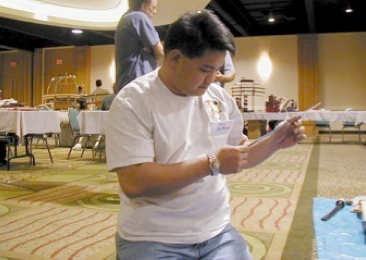John De Mesa – TogiShi

John De Mesa – TogiShi.
Traditional Japanese sword polishing is a trade that takes a lot of patience to learn. In Japan, it takes 10 years of apprenticing to properly learn Togi (Japanese Sword Polishing). One of the most important things about learning Togi is Kantei (Sword Judging), which is very important when polishing antique nihonto. This requires years of study in how a blade is supposed to be shaped, judging by the smith, blade style, hataraki, school, era of when the blade was made and so on.
I’ve admired the beauty of the Japanese sword since I was young. My interest in this craft lies in using traditional methods polishing modern Japanese style blades made by North American smiths, as well as Shinsakuto, which are made in Japan. Mostly Japanese style swords made by in the US by some of the most talented smiths that I know. Howard Clark, Louis Mills, are good friends of mine that I work closely with, as well blades made by other US Smiths. I’ve also worked on some Shinshakuto from Japan, some Gendaito and a couple of nihonto from my personal collection.
I do not polish swords for fame or fortune, recognition nor competition. I do it because I enjoy polishing and to keep the craft alive. I enjoy being able to meet and work with some of the best craftsmen in the country and overseas. Most are usually nice and are open to help, teach and share information. At times they are even willing take someone in to be their student so they can pass along the knowledge to keep the craft alive. It takes a lot of hard work and patience in order to properly polish a sword. There are different ways of properly polishing and finishing a blade. I’m not saying that one is better than the other, its more of a matter of what the blade “needs” or personal preference. My knowledge comes from studying high end nihonto, proper geometry, symmetry, style, shape, contrast, how the hataraki is brought out. I’m an admitted non-traditionalist. I am not bound to traditional methods when I know other ways of achieving a certain look that I want out of a blade. I apply a combination of both traditional and methods that I’ve developed through years of experimentation when I’m polishing Japanese style blades made by US smiths to give them a more traditional look. However when I’m working on nihonto, I will only use traditional methods.